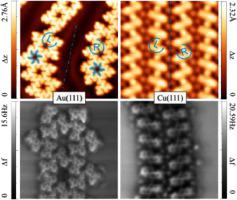Chinese Chemical Letters ( IF 9.4 ) Pub Date : 2022-01-04 , DOI: 10.1016/j.cclet.2021.12.082 Shijie Sun 1 , Baijin Li 1 , Boyu Fu 1 , Zilin Ruan 1 , Hui Zhang 1 , Wei Xiong 1 , Yong Zhang 1 , Gefei Niu 1 , Jianchen Lu 1 , Xiaoqing Zuo 1 , Lei Gao 2 , Jinming Cai 1

|
Nanoscale low-dimensional chiral architectures are increasingly receiving scientific interest, because of their potential applications in many fields such as chiral recognition, separation and transformation. Using 6,12-dibromochrysene (DBCh), we successfully constructed and characterized the large-area two-dimensional chiral networks on Au(111) and one-dimensional metal-liganded chiral chains on Cu(111) respectively. The reasons and processes of chiral transformation of chiral networks on Au(111) were analyzed. We used scanning tunneling spectroscopy (STS) to analyze the electronic state information of this chiral structure. This work combines scanning tunneling microscopy (STM) with non-contact atomic force microscopy (nc-AFM) techniques to achieve ultra-high-resolution characterization of chiral structures on low-dimensional surfaces, which may be applied to the bond analysis of functional nanofilms. Density functional theory (DFT) was used to simulate the adsorption behavior of the molecular and energy analysis in order to verify the experimental results.
中文翻译:

Au(111) 和 Cu(111) 表面上 6,12-二溴的手性结构
纳米级低维手性结构因其在手性识别、分离和转化等许多领域的潜在应用而越来越受到科学界的关注。使用 6,12-dibromochrysene (DBCh),我们分别成功构建并表征了 Au(111) 上的大面积二维手性网络和 Cu(111) 上的一维金属配体手性链。分析了Au(111)上手性网络手性转变的原因和过程。我们使用扫描隧道光谱(STS)来分析这种手性结构的电子态信息。这项工作将扫描隧道显微镜 (STM) 与非接触原子力显微镜 (nc-AFM) 技术相结合,以实现对低维表面手性结构的超高分辨率表征,可应用于功能纳米薄膜的键合分析。为了验证实验结果,采用密度泛函理论(DFT)模拟分子的吸附行为并进行能量分析。







































 京公网安备 11010802027423号
京公网安备 11010802027423号